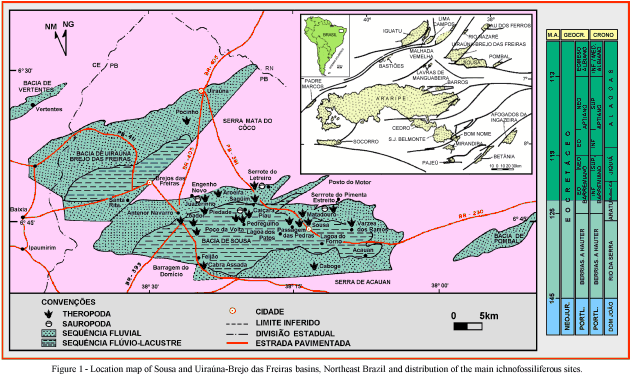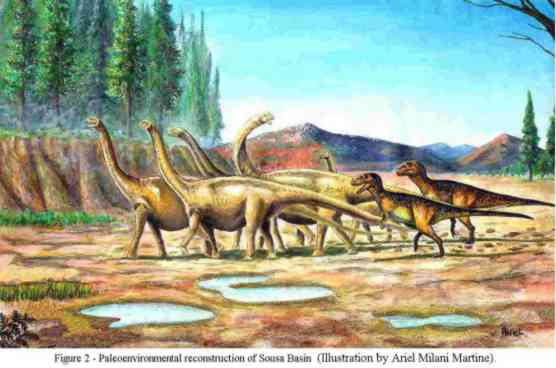Bonaparte,J.F. 1986. History of the terrestrial Cretaceous
Vertebrates of Gondwana. In: Congreso Argentino de Paleontología y Bioestratigrafía, 4.
Mendoza, Argentina, vol. 2: 63-95.
Bonaparte,J.F.; Novas,F.E. 1985. Abelisaurus camahuensis
n.g., n.sp., Carnosauria del Cretácico Tardio de Patagonia. Ameghiniana, 21(2-4):
259-265, 2 figs. Buenos Aires, Argentina.
Bonaparte,J.F.; Powell,J.E. 1980. A continental assemblage of
tetrapods from the Upper Cretaceous beds of El Brete, NW Argentina (Sauropoda
Coelurosauria Carnosauria Aves). Mémoires de la Société Géologique de France,
N.S., Paris,(1980), 139: 19-28, 9 figs.
Carvalho,I.S. 1989. Icnocenoses continentais: bacias de Sousa,
Uiraúna-Brejo das Freiras e Mangabeira. (Universidade Federal do Rio de Janeiro,
Programa de Pós-Graduação em Geologia). Dissertação de Mestrado, 167p. (inédita),
Rio de Janeiro.
Carvalho, I.S. 1993. Os conchostráceos fósseis das bacias
interiores do Nordeste do Brasil. (Universidade Federal do Rio de Janeiro, Programa de
Pós-Graduação em Geologia). Tese de Doutorado, 2 v., 319 p. (texto) (inédita), Rio de
Janeiro.
Carvalho, I.S. 1996a. As pegadas de dinossauros da bacia de
Uiraúna-Brejo das Freiras (Cretáceo Inferior, estado da Paraíba). In: Simpósio sobre o Cretáceo do Brasil, 4, Rio Claro, São Paulo, Brasil. Boletim:115-121
Carvalho, I.S. 1996b. Paleogeographic distribution of esthereliidean
conchostraceans on the Cretaceous rift interior basins of Northeastern Brazil. In:
Congresso Brasileiro de Geologia, 39, Salvador-BA, 1996, SBG. Anais, 7:
387-389.
Carvalho, I.S. 2000a. Geological environments of dinosaur footprints in
the intracratonic basins from Northeast Brazil during the South Atlantic opening (Early
Cretaceous). Cretaceous Research, pre-print.
Carvalho, I.S. 2000b. Huellas de saurópodos de la Formación Antenor
Navarro (Cretácico Temprano de la Cuenca de Sousa), Serrote do Letreiro, Paraíba,
Brasil. Ameghiniana, pre-print, Argentina.
Carvalho, I.S.; Carvalho,M.G.P. 1990. O significado
paleoambiental dos conchostráceos da Bacia de Sousa. In: Simpósio sobre a Bacia do Araripe e Bacias Interiores do Nordeste, 1, Crato-PE, 1990, SBP.
Anais: 329-333.
Carvalho, I.S.; Leonardi,G. 1992. Geologia das bacias de Pombal,
Sousa, Uiraúna-Brejo das Freiras e Vertentes (Nordeste do Brasil). Anais da Academia
Brasileira de Ciências(1992), Rio de Janeiro, 64(3): 231-252.
Carvalho, I.S.; Viana,M.S.S.; Lima Filho,M.F. 1994. Dinossauros
do Siluriano: um anacronismo crono-geológico nas bacias interiores do Nordeste?
In: Congresso Brasileiro de Geologia, 38,
Camboriú-SC,1994,
SBG. Boletim de Resumos Expandidos,3: 213-214.
Carvalho, I.S.; ; Viana, M.S.S.; Lima Filho, M.F.
1995. Bacia de
Cedro: a icnofauna cretácica de vertebrados. Anais da Academia Brasileira de Ciências(1995), Rio de
Janeiro, 67(1): 25-31.
Coria,R.A.; Salgado,L. 1996. A basal iguanodontian
(Ornithischia: Ornithopoda) from the Late Cretaceous of South America. Journal of
Vertebrate Paleontology (1996), 16(3): 445-457.
Fernandes,A.C.S.; Carvalho, I.S. 1997. Icnofósseis de
invertebrados da bacia de Sousa (estado da Paraíba, Brasil): a localidade de Serrote do
Letreiro. In: Simpósio sobre a Bacia do Araripe e Bacias Interiores do Nordeste, 2, Crato-PE, 1997. Resumo das Comunicações:29.
Godoy,L.C.; Leonardi,G. 1985. Direções e comportamento dos
dinossauros da localidade de Piau, Sousa, Paraéba (Brasil), Formação Sousa (Cretáceo
Inferior). In: Brasil, DNPM. Coletânea de Trabalhos Paleontológicos. Série
"Geologia", 27 (Seção Paleontologia e Estratigrafia, 2): 65-73, 4 figs., col.
stratigraph.. Brasília.
Huene,F. 1931. Verschiedene mesozoische Wierbeltierreste aus
Südamerika. Neuen Jahrbuch für Mineralogie, Geologie, Paläontologie, Beil-Bd. 66(B):
181-198, 21 figs., Alemanha.
Leonardi,G. 1979a. Nota Preliminar Sobre Seis Pistas de Dinossauros
Ornithischia da Bacia do Rio do Peixe (Cretáceo Inferior) em Sousa, Paraíba, Brasil.
Anais da Academia Brasileira de Ciências(1979), Rio de Janeiro, 51(3): 501-516, 19 figs.
Leonardi,G. 1979b. New Archosaurian trackways from the Rio do Peixe
Basin, Paraíba, Brazil. Annali dell'Universitat di Ferrara, N.S., S.IX, 5(14): 239-249,
18 figs., 2 tabs. Ferrara.
Leonardi, G. 1980a. Vertebate ichnology in
Brazil and Italy. Ichnology Newsletter,Menlo Park, California, USA
(1980), 11:10.
Leonardi,G. 1980b. Isochirotherium sp.: Pista de um
gigantesco Tecodonte na Formação Antenor Navarro (Triássico), Sousa, Paraíba, Brasil.
Revista
Brasileira de Geociências(1980), 10(4): 186-190.
Leonardi,G. 1980c. Dez novas pistas de Dinossauros (Theropoda Marsh,
1881) na Bacia do Rio do Peixe, Paraíba, Brasil. In: Congreso
Latinoamericano de Paleontología, 1er, Buenos Aires, 1978. Actas1:
243-248, 1 pl., 1 tab.
Leonardi,G. 1984a. Le impronte fossili di dinosauri. In: Bonaparte,
J.F. et al., Sulle orme dei dinosauri. Venezia-Mestre, Erizzo, 1984. (Esplorazioni e
ricerche, IX), 335 p.: 161-186, 27 pls., 13 figs., Itália.
Leonardi,G. 1984b. Rastros de um mundo perdido.
Ciência Hoje (1984), 2(15):
48-60, 16 figs, 4 boxes, 1 tab., cover.
Leonardi,G. 1985. Mais pegadas de dinossauros na Paraíba.
Ciência
Hoje(1985), 3(16): 94, 1 fig.
Leonardi,G. 1987. Pegadas de dinossauros (Carnosauria, Coelurosauria,
Iguanodontidae) na Formação Piranhas da Bacia do Rio do Peixe, Sousa, Paraíba, Brasil.
In: Moura, J.A. & H.M.N. Gilson (coord.)., Congresso Brasileiro de
Paleontologia, 10, Rio de Janeiro, 19-25 jul 1987, Sociedade Brasileira de
Paleontologia. Anais, 2 vol., 1: 337-351, 3 pl., 1 tab., Brasil.
Leonardi,G. 1989. Inventory and Statistics of the South American
Dinosaurian Ichnofauna and its Paleobiological Interpretation. In: Gillette, D.D. &
M.G. Lockley (eds). Dinosaur Tracks and Traces. Cambridge, Cambridge University
Press, 1989. 454 p., illustr.: 165-178, 4 pls., Brasil.
Leonardi,G. 1994. Annotated Atlas of South America Tetrapod
Footprints (Devonian to Holocene) with an appendix on Mexico and Central America.
Brasília, Companhia de Pesquisa de Recursos Minerais, 1994. 248 p., 35 pls., 27 figs.,
tabs., Brasil.
Leonardi,G.; Muniz,G.C.B. 1995. Observações icnológicas
(Invertebrados e Vertebrados) no Cretáceo Continental do Ceará (Brasil), com menção a
moluscos dulçaquícolas. IX Congresso Brasileiro de Paleontologia. Fortaleza,
01-07.09.1985. Resumo das Comunicações: 45 (abstract), Brasil.
Leonardi,G.; Spezzamonte,M. 1994b. New tracksites (Dinosauria:
Theropoda and Ornithopoda) from the Lower Cretaceous of the CearÁ, Brasil. Studi
Trentini di Scienze Naturali - Acta Geologica, 69 (1992): 61-70, 5 figs., 2
tabs. Trento.
Leonardi, G.; Lima,C.V.; Lima,F.H.O. 1987c. Os dados
numéricos relativos às pistas (e suas pegadas) das Icnofaunas dinossaurianas do
Cretáceo inferior da Paraíba, e sua interpretação estatística. III - Estudo
estatístico. In: Moura, J.A. & H.M.N. Gilson (coord.) Anais do X Congresso Brasileiro
de Paleontologia. Rio de Janeiro, 19-25 jul 1987. Rio de Janeiro, Sociedade Brasileira de
Paleontologia, 1987. 2 vol., 1: 419-444, 7 pls., Brasil.
Leonardi,G.; Lima,L.C.; Lima,C.V.; Lima,F.H.O. 1987a. Os
dados numéricos relativos às pistas (e suas pegadas) das Icnofaunas dinossaurianas do
Cretáceo inferior da Paraíba, e sua interpretação estatística. I - Parâmetros das
pistas. In: Moura, J.A. & H.M.N. Gilson (coord.) Anais do X Congresso Brasileiro de
Paleontologia, Rio de Janeiro, 19-25 jul 1987. Rio de Janeiro, Sociedade Brasileira de
Paleontologia, 1987. 2 vol., 1: 377-394, 1 fig., 14 tabs., Brasil.
Leonardi,G.; Lima, L.C.; Lima, C.V.; Lima, F.H. O.
1987b. Os
dados numéricos relativos às pistas (e suas pegadas) das Icnofaunas dinossaurianas do
Cretáceo inferior da Paraíba, e sua interpretação estatística. II - Parâmetros das
pegadas. In: Moura, J.A. & H.M.N. Gilson (coord.) Anais do X Congresso Brasileiro
de Paleontologia. Rio de Janeiro, 19-25 jul 1987. Rio de Janeiro, Sociedade Brasileira
de Paleontologia, 1987. 2 vol., 1: 395-417, 1 fig., 13 tabs., Brasil.
Lima Filho,M.F. 1991. Evolução tectono-sedimentar da Bacia do Rio
do Peixe - PB. (Universidade Federal de Pernambuco). Dissertação de Mestrado, 99 p.
(inédita).
Lima Filho, M.F.; Mabesoone,J.M.; Viana,M.S.S. 1999. Late
Mesozoic History of Sedimentary Basins in NE Brazilian Borborema Province before the final
separation of South America and Africa 1: Tectonic-Sedimentary Evolution. In: Simpósio sobre o Cretáceo do Brasil, 5.
Boletim... Rio Claro, 1999, p. 605-611, Brasil.
Lima,M.R. 1983. Paleoclimatic reconstruction of the Brazilian
Cretaceous basins on palynological data. Revista Brasileira de Geociências, 13(4):
223-228, Brasil.
Lima,M.R.; Coelho,M.P.C.A. 1987. Estudo palinológico da
sondagem estratigráfica da Lagoa do Forno, Bacia do Rio do Peixe, Cretáceo do Nordeste
do Brasil. Boletim do Instituto de Geociências - USP, Série Científica 18, p.
67-83, Brasil.
Mabesoone,J.M. 1972. Sedimentos do Grupo Rio do Peixe (Paraíba). In:
Congresso Brasileiro de Geologia, 26, Belém, 1972, Sociedade Brasileira de
Geologia. Boletim,1: 236.
Mabesoone, J.M.; Campanha,V. 1974. Caracterização
estratigráfica dos grupos Rio do Peixe e Iguatu. Estudos Sedimentológicos, Natal,
3/4, p. 21-41.
Moraes,L.J. 1924. Serras e montanhas do Nordeste. Brasil,
Inspetoria Obras contra Seccas. Publicação Série I. D. 58, 2 vol. xi+122p; 122 p. Rio
de Janeiro.
Petri,S. 1983. Brazilian Cretaceous paleoclimates: evidence from
clay-minerals, sedimentary structures and palynomorphs. Revista Brasileira de
Geociências, 13(4): 215-222, Brasil.
Petri, S. 1998. Paleoclimas da era Mesozóica no Brasil - evidências
paleontológicas e sedimentológicas. Revista Universidade Guarulhos, 6, p. 22-38,
Brasil.
Price,L.I. 1961. Sobre os dinossáurios do Brasil.
Anais da
Academia brasileira de Ciências, 33(3-4): xxviii-xxix (abstract). Rio de
Janeiro.
Regali,M.S.P. 1990. Biocronoestratigrafia e paleoambiente do Cretáceo
das bacias do Araripe (CE) e Rio do Peixe (PB), Nordeste do Brasil. In: Simpósio sobre a Bacia do Araripe e Bacias Interiores do Nordeste, 1, Crato, 1990.
Anais... Crato,
SBP, p. 163-172, Brasil.
Santos,M.F.C.S.; Santos,C.L.A. 1987a. Sobre a ocorrência de
pegadas e pistas de dinossauros na localidade de Engenho Novo, Antenor Navarro, Paraíba
(Grupo Rio do Peixe, Cretáceo Inferior). In: Moura, J.A. & H.M.N. Gilson (coord.)
Anais
do X Congresso Brasileiro de Paleontologia. Rio de Janeiro, 19-25 jul 1987. Rio de
Janeiro, Sociedade Brasileira de Paleontologia, 1987. 2 vol., 1: 353-366, 8 figs., 1 tab.,
Brasil.
Santos, M.F.C.S.; Santos, C.L. A. 1987b. Novas pegadas de
dinossauros retiradas de uma cerca de pedras no sítio Cabra Assada , Antenor Navarro,
Paraíba (Grupo Rio do Peixe, Cretáceo Inferior). In: Moura, J.A. & H.M.N. Gilson
(coord.) Anais do X Congresso Brasileiro de Paleontologia. Rio de Janeiro, 19-25
jul 1987. Rio de Janeiro, Sociedade Brasileira de Paleontologia, 1987. 2 vol., 1: 367-376,
13 figs., 1 tab., Brasil.
Viana,M.S.S.; Lima Filho,M.F.; Carvalho,I.S. 1993. Borborema megatracksite:
uma base para correlação dos arenitos inferiores das bacias interiores do Nordeste do
Brasil. In: Simpósio de Geologia do Nordeste, 15,
SBG/Núcleo Nordeste. Boletim,13:23-25.







